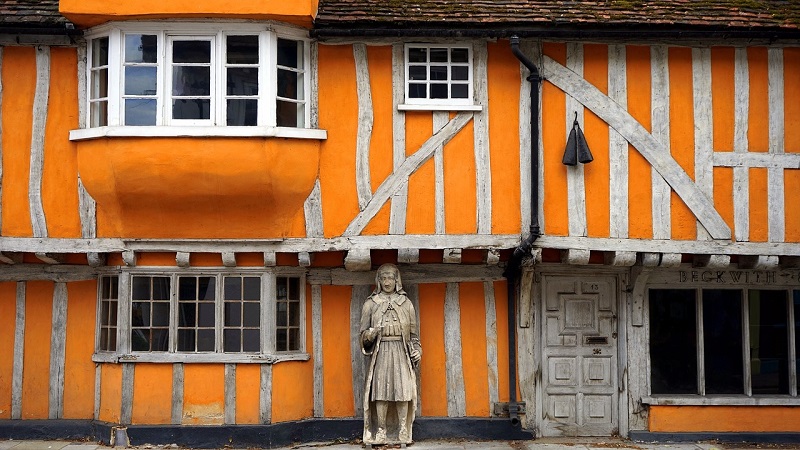Jetty

|
| The jetty seen on this house is created by projecting timber floor beams at first floor level. |
Traditionally, jettying was the art of creating overhangs as seen in timber-framed houses of the 14th to 17th centuries. The jetty (or jettie or jutty; derr. French ‘jeter’ to throw) refers to situations in which the upper floor overhangs the floor below by as much as 1,200mm (although usually around 400mm). If a house comprised two storeys above ground, the second storey would often overhang by as much as the one below.
A jetty would often exist on the front of the house where it was most visible, although some houses show them on both front and back.
[edit] Reasons to jetty
Although the exact reason for jettying is not known, the most commonly-cited explanation is the need to provide extra space. While this is plausible – especially in the confined conditions of a medieval town – many of these buildings were in rural areas which did not have the same spatial constraints. In any case, the space provided by a modest jetty may not have yielded significant usable space.
Other possible reasons include:
- Fashion: If jettying originally started in towns, rural builders may simply have been keen to be seen ‘keeping up with the times’ and offering the latest building techniques.
- Structural 1: A heavy item of furniture in the middle of an upper floor room could, over time, cause sagging of the floor joists. By placing such heavy items in or close to the jetty – and therefore directly above or closer to the point where the joists bear on the wall below – much of the weight of the item is directed to the wall below and could also straddle over the wall.
- Structural 2: In a house with a two-storey central hall, jettying would require timbers only one-storey high, as opposed to timbers that extended right up to the eaves.
- Social status: Jettying was an added expense to the cost of building so having a jetty may have been a way of expressing the wealth of the householder.
- Weathering: These buildings seldom had eaves' gutters and downpipes so much of the water running-off the roof would flow down the walls. The inclusion of a jetty may simply have been a precaution against damp, protecting the lower floor from run-off.
The term ‘jetty’ is rarely used in modern building; ‘overhang’, ‘projection’ and ‘cantilever’ are more common.
NB the term 'jetty' is also commonly used to refer to a structure, typically a walkway, that projects into a waterbody from the land.
A jetty bracket is: 'A supporting timber, usually curved, used to give added strength to jettied upper storeys in medieval buildings.' Ref Drawing for Understanding, Creating Interpretive Drawings of Historic Buildings, published by Historic England in 2016.
[edit] Related articles on Designing Buildings Wiki
- Advantages and disadvantages of timber frame buildings.
- Balloon framing.
- Cruck.
- Delivering sustainable low energy housing with softwood timber frame.
- Post.
- Sacrificial timber.
- Skeleton frame.
- Stud.
- Testing timber.
- Timber.
- Timber framed buildings and fire.
- Timber post and beam construction.
- Timber preservation.
- Types of frame.
- Types of timber.
IHBC NewsBlog
Old Sarum fire in listed (& disputed) WW1 Hangar - Wiltshire Council has sought legal advice after fire engulfed a listed First World War hangar that was embroiled in a lengthy planning dispute.
UK Antarctic Heritage Trust launches ‘Virtual Visit’ website area
The Trust calls on people to 'Immerse yourself in our heritage – Making Antarctica Accessible'
Southend Council pledge to force Kursaal owners to maintain building
The Council has pledged to use ‘every tool in the toolbox’ if urgent repairs are not carried out.
HE’s Research Magazine publishes a major study of the heritage of England’s suburbs
The article traces the long evolution of an internal programme to research 200 years of suburban growth
IHBC Context 183 Wellbeing and Heritage published
The issue explores issues at the intersection of heritage and wellbeing.
SAVE celebrates 50 years of campaigning 1975-2025
SAVE Britain’s Heritage has announced events across the country to celebrate bringing new life to remarkable buildings.
IHBC Annual School 2025 - Shrewsbury 12-14 June
Themed Heritage in Context – Value: Plan: Change, join in-person or online.
200th Anniversary Celebration of the Modern Railway Planned
The Stockton & Darlington Railway opened on September 27, 1825.
Competence Framework Launched for Sustainability in the Built Environment
The Construction Industry Council (CIC) and the Edge have jointly published the framework.
Historic England Launches Wellbeing Strategy for Heritage
Whether through visiting, volunteering, learning or creative practice, engaging with heritage can strengthen confidence, resilience, hope and social connections.













